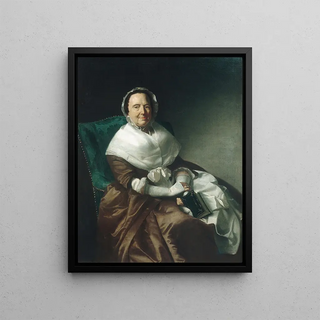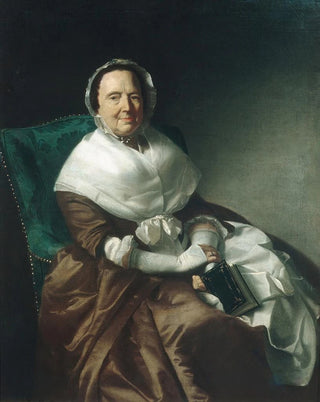Art print | Mme Sylvanus Bourne - John Singleton Copley


View from behind

Frame (optional)
In the fascinating universe of 18th-century painting, the art print "Mme Sylvanus Bourne" by John Singleton Copley stands out for its elegance and psychological depth. This painting, which captures the very essence of its subject, is much more than a simple portrait. It evokes a time when art served to immortalize not only appearance but also personality and social status. Contemplating this work, the viewer is transported to a world where Copley's talent is expressed through meticulous details and thoughtful composition, revealing a rare intimacy between the artist and her model.
Style and uniqueness of the art print
Copley's style is characterized by striking realism, mastery of colors, and particular attention to textures. In "Mme Sylvanus Bourne," each element is carefully orchestrated to create an atmosphere of dignity and grace. The woman's face, delicately lit, seems almost alive, while the drapery of her dress suggests discreet luxury. The way Copley plays with light and shadow gives an almost three-dimensional quality to the figure, making it palpable and accessible. The background, though secondary, contributes to the harmony of the whole, adding depth that draws the eye toward the main subject. This portrait is not limited to a simple representation; it tells a story, that of a woman of her time, while reflecting the values and aspirations of a society in full transformation.
The artist and his influence
John Singleton Copley, born in Boston in 1738, is often regarded as one of the greatest American portraitists of his era. His artistic training, marked by meticulous observation of human nature and a desire to transcend conventions, allowed him to stand out in the art world. Copley was able to capture not only the physical appearance of his models but also their character and essence. His works, often commissioned by the elite of society, testify to a time when art was a powerful vehicle of social status. Copley's influence extends beyond American borders, inspiring many European artists and

Matte finish

View from behind

Frame (optional)
In the fascinating universe of 18th-century painting, the art print "Mme Sylvanus Bourne" by John Singleton Copley stands out for its elegance and psychological depth. This painting, which captures the very essence of its subject, is much more than a simple portrait. It evokes a time when art served to immortalize not only appearance but also personality and social status. Contemplating this work, the viewer is transported to a world where Copley's talent is expressed through meticulous details and thoughtful composition, revealing a rare intimacy between the artist and her model.
Style and uniqueness of the art print
Copley's style is characterized by striking realism, mastery of colors, and particular attention to textures. In "Mme Sylvanus Bourne," each element is carefully orchestrated to create an atmosphere of dignity and grace. The woman's face, delicately lit, seems almost alive, while the drapery of her dress suggests discreet luxury. The way Copley plays with light and shadow gives an almost three-dimensional quality to the figure, making it palpable and accessible. The background, though secondary, contributes to the harmony of the whole, adding depth that draws the eye toward the main subject. This portrait is not limited to a simple representation; it tells a story, that of a woman of her time, while reflecting the values and aspirations of a society in full transformation.
The artist and his influence
John Singleton Copley, born in Boston in 1738, is often regarded as one of the greatest American portraitists of his era. His artistic training, marked by meticulous observation of human nature and a desire to transcend conventions, allowed him to stand out in the art world. Copley was able to capture not only the physical appearance of his models but also their character and essence. His works, often commissioned by the elite of society, testify to a time when art was a powerful vehicle of social status. Copley's influence extends beyond American borders, inspiring many European artists and






